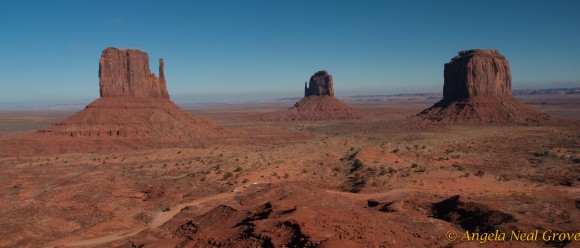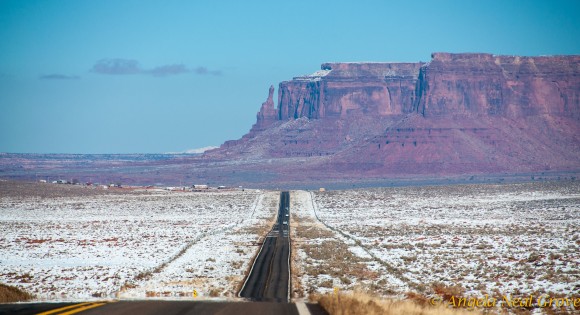
Monument Valley was not on the schedule. It was the day before Thanksgiving and we were headed south towards the Arizona border. When the GPS died we took a wrong turn and found ourselves on a two-lane highway in a valley from another world. A place where towering russet sandstone buttes silently stood sentinel.
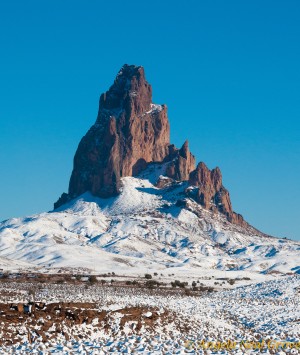
An early snowstorm had frosted the scene and the monoliths were capped with snowy topknots. The vista was 360 degrees. Every direction looked like a travel brochure extolling the beauty of the American South West, except this was better. The cold air made the roadside snow glitter and sparkle. It was magical. It was also, for me, one of life’s seminal moments.
For years I had resisted the suggestion to explore the great open spaces of America’s South West. After all, I am from England’s green and pleasant land of postage-stamp fields and hedges. I brushed off the idea. “I prefer my deserts with camels,” I glibly responded, thinking of Lawrence of Arabia’s Wadi Rum in Jordan, North African desert salt flats and the Taklamakan Desert of China’s Ancient Silk Road. All favorites I had visited and written about. That was enough I had done deserts. Besides I had looked out of window on transcontinental flights and seen an arid brown land with straight, lonely roads leading seemingly nowhere. It did not appeal.
But this was fly-over zone no longer. The scene was simply breathtaking. It was awe inspiring and yet familiar. Familiar? I am not much of a western movie buff but wasn’t this the backdrop for some movie?
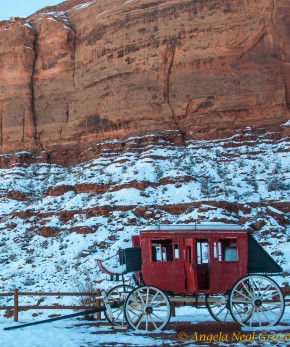
Reality check. We were still lost and not headed towards our ultimate destination. We pulled off and into Gouldings Trading Post. Tucked up against a bluff was a small hotel, shop with Indian handicrafts, tiny museum and outside, in the snow a stagecoach. That was it! Stagecoach! It was the John Ford movie starring John Wayne, that put Monument Valley on the international map and made it synonomous with the Grand Western landscape.
Harry Goulding, son of Colorado sheep herders, came to the 30,000 acre valley in the 20’s. It was Navajo land but he was able to stake a claim. He respected and loved the Navajo and in turn they trusted him. Then came the year of 1938, an especially hard time in the valley. As well as the depression a severe drought caused huge loss of livestock. Goulding heard Hollywood was making a western – he was determined it would be located in the valley. The legendary story goes that he went to LA and threatened to overnight in the reception area of United Artisits. He attracted the attention of Director John Fordand the rest is history.
For more about Harry Goulding and his trip to Hollywood see below. He is pictured with his wife Leone whom he called Mike as he found her name hard to pronounce
The movie crew arrived, coping with dusty roads which turned to red sticky paste when it rained. They created a tent city they called Hollywood and Vine. Harry was the go-between with the Navajo – many of whom were extras in the movie. John got union wages for them.
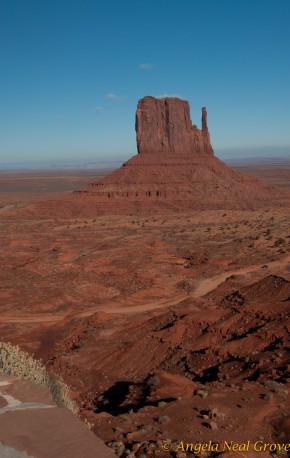
After that a series of movies were made in the area. Tourists began to arrive, principally from Japan and Germany. A two-lane highway was eventually constructed. Recently a new hotel has been built. But this is still Navajo land and the scene remains pristine.
John Ford thought the valley the “most beautiful, complete, peaceful and spiritual” place he had ever been. I concur and I can’t wait to return. What serendipity the GPS failed the day before Thanksgiving in such a very American place.
The site was added to the National Register of Historic Places on October 20, 1980.
